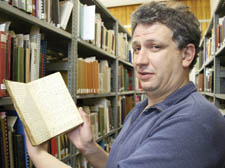|
|
 |
| |

Archivist Tudor Allen at the Local Studies Archive based at Holburn Library |
Secret diary of Stevenson, the Heath common keeper
Meticulous re-discovered notes kept by a 19th-century patrolman suggest little has changed on Hampstead Heath, writes Dan Carrier
JOHN Stevenson lay still in the bushes and watched carefully as the gang of men dug up turf, sand and gravel.
They were loading it into sacks and hoisting them on to a cart. Stevenson had caught them at it and stepped out from his hiding place to challenge them. But the elderly man, who held the post of common keeper of the manor of St John’s Hampstead, was no match for the thieves. They knocked him over and made off.
This incident in the spring of 1834 is detailed in Stevenson’s diary – the keeper was employed to manage and patrol Hampstead Heath and he kept a daily record over four years, recently
re-discovered at the
Holborn Local Studies Archive at Holborn Library on Theobalds Road. It offers a
fascinating glimpse into life on the Heath nearly 200 years ago. He marks such events as the building of a ceremonial arch to honour King William IV and a party that took place underneath it.
The theft of turf and gravel was widespread – the Heath was seen as a resource that was open to all. Stevenson regularly chased cows and their minders off the land and had a pound by
Whitestone Pond to keep errant pigs who had been taken on to the Heath by their owners to root about for food.
Starting in July 1834, his spindly writing describes his work as a patrolman, which
included working through the night to
protect the Heath’s
natural resources. He had the full weight of the law behind him – for seemingly minor offences, such as cutting wood, perpetrators could be transported to Australia.
As his diary notes, he also had a lot of trouble with
village boys.
He caught a gang cutting furze bushes to use for bonfires on Guy Fawkes Day.
The diary reads: “Oct 29, 1834 – Mrs Herbert’s sweep boys cutting furze for bonfires, went to see Mrs Herbert, going round North End. Met boys with furze, boys ran away but two Young Gents of the swell mob stopt (sic) and struck at me with fork. I rescued the fork and have got it at, my house, they ran away, I after them but they outrun me, fork marked L.R.”
Stevenson also caught boys setting light to furze bushes on the Heath. The penalty for such behaviour was incredibly harsh. He managed to detain them and took them before the parish constable, a Henry Hunt. Hunt said he’d try them and if found guilty they’d get “seven years deportation” – meaning a trip to Australia – or “two years confinement and twice whipped”.
The origins of how the diary came to be in the archives is unclear. Archivist Tudor Allen believes it was originally handed to the Holborn centre by Hampstead borough council when Camden was established in 1965. They would have got it from the Hampstead parish council files, and it was probably placed there when the great battle to secure the Heath as open land for ever was being fought. Documents such as the diary were amassed to use as evidence of the relationship people have had with the Heath over the years.
“There were quite a lot of documents treating to this which were collected at this time of the dispute,” says Mr Allen.
And we know little about Stevenson – no pictures of him exist – except that he did his job thoroughly, often putting himself in grave physical danger to carry out his work, and was diligent in filling out his diary each day.
While today’s parkies don’t have to spend too long chasing people who have stolen sand and gravel, other issues Stevenson writes about are just as relevant today. He outlines the case of a man in the Vale of Health – then a tiny settlement nestling in the valley off East Heath Road – building a home that was deemed to encroach on the Heath.
The Heath and Hampstead Society last year won a landmark High Court ruling over a planning application to build a new home in the Vale – and as the diary shows, even in the 1830s, this was taken very seriously.
On October 13, 1834, Stevenson noted that he had been accosted by a home-owner who accused him of telling the Lord of the Manor that the home he was building encroached on the open land.
“Going round the Vale, Mr Munyard came from the garden...Called Stevenson, said you darned old rascal, aren’t you a pretty fellow to tell Lyddon I have encroached on the Lords...I have not...”
Stevenson fights his corner: “I beg pardon sir, look here. Have you not nearly two feet in this foundation?”
But Stevenson’s accusations are met with a volley of abuse – which he notes carefully, as he does regularly.
“You scoundrel, if I ever know you to set foot on my premises again I will enter action against you...” replied the angry Munyard, adding that he had only dug out the foundations and had yet to raise a wall.
Other issues that regularly arose will also resonate today: fly- tipping was a major problem, although it tended to be garden rubbish rather than
plastic bags of litter, and parties lighting fires. In September 1834, Stevenson writes: “Two London tea parties...I told them they must put the fire out direct or charges would be taken accordingly.”
For today’s Heath constabulary, who have spent much time this summer telling people not to have barbecues, this shows it is an ,age-old problem. |

|
 |
| |
|
 |
|

